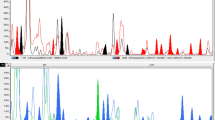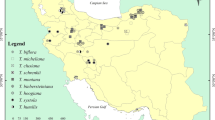Abstract
For the first time amplified fragment length polymorphism (AFLP) fingerprinting is applied to classify tropical African Festuca species. Five afro-alpine narrow- and two afro-montane broad-leaved species from Uganda and Ethiopia are compared to ten European grass species. A principal coordinate analysis (PCoA) accounts for 62.5% with its first three coordinates. The PCoA and the neighbor-joining (NJ) distinguish the five narrow-leaved African Festuca species from all other species. The broad-leaved African Festuca africana and Festuca simensis are linked to the broad-leaved European species through Festuca altissima and Festuca gigantea, respectively. The narrow- and broad-leaved European species are separated as expected in the NJ. One narrow-leaved African alpine species recently described appears merged (i.e. Festuca richardii with Festuca abyssinica). We provide chromosome numbers for all seven Ugandan species and compare taxonomy and AFLP classification. Our most striking result is that the narrow-leaved African Festuca species are unique and not clustering with the narrow-leaved European species.



Similar content being viewed by others
References
Alexeev EB (1986) New narrow-leaved Festuca (Poaceae) members from Tropical and South Africa. Bot Zhurnal 71:1109–1117
Alexeev EB (1987) Fescues of the Festuca abyssinica s. l. (Poaceae) group. Bot Zhurnal 72:1260–1268
Alm V, Fang C, Busso CS, Devos KM, Vollan K, Grieg Z, Rognli OA (2003) A linkage map of meadow fescue (Festuca pratensis Huds.) and comparative mapping with other Poaceae species. Theor Appl Genet 108:25–40
Arohonka T (1982) Chromosome counts of vascular plants of the island Seili in Nauvo, southwestern Finland. Biol Geogr 3:1–12
Barker CM, Stace CA (1984) Hybridization in the genera Vulpia and Festuca (Poaceae): the characteristics of artificial hybrids. Nord J Bot 4:289–302
Becker J, Vos P, Kuiper M, Salamini F, Heun M (1995) Combined mapping of AFLP and RFLP markers in barley. Mol Gen Genet 249:65–73
Catalan P, Torrecilla P, Lopez Rodriguez JA, Olmstead RG (2004) Phylogeny of the festucoid grasses of subtribe Loliinae and allies (Poeae, Pooideae) inferred from ITS and trnL–F sequences. Mol Phylogenet Evol 31:517–541
Charmet G, Ravel C, Balfourier F (1997) Phylogenetic analysis in the Festuca–Lolium complex using molecular markers and ITS rDNA. Theor Appl Genet 94:1038–1046
Clayton WD (1970) Gramineae, Part 1. In: Milne-Redhead E, Polhill RM (eds) Flora of Tropical East Africa. Crown Agents for Oversea Governments and Administrations, London, pp 56–63
Clayton WD, Renvoize SA (1986) Genera graminum: grasses of the world. HMSO, London, pp 374–375
Darbyshire SJ, Warwick SI (1992) Phylogeny of North American Festuca (Poaceae) and related genera using chloroplast DNA restriction site variation. Can J Bot 70:2415–2429
Fjellheim S, Elven R, Brochmann C (2001) Molecules and morphology in concert. II. The Festuca brachyphylla complex (Poaceae) in Svalbard. Am J Bot 88:869–882
Fjellheim S, Rognli OA (2005a) Genetic diversity within and among Nordic meadow fescue (Festuca pratensis Huds.) cultivars determined on the basis of AFLP markers. Crop Sci 45:2081–2086
Fjellheim S, Rognli OA (2005b) Molecular diversity of local Norwegian meadow fescue (Festuca pratensis Huds.) populations and Nordic cultivars—consequences for management and utilization. Theor Appl Genet 111:640–650
Gaut BS, Tredway LP, Kubik C, Gaut RL, Meyer W (2000) Phylogenetic relationships and genetic diversity among members of the Festuca–Lolium complex (Poaceae) based on ITS sequence data. Plant Syst Evol 224:33–53
Hedberg O (1957) Afroalpine vascular plants; a taxonomic revision. Symb Bot Upsal XV:1
Jenczewski E, Alix K (2004) From diploids to allopolyploids: the emergence of efficient pairing control genes in plants. Crit Rev Plant Sci 23:21–45
Jenkin TJ (1959) Fescue species (Festuca L.). In: Kappert H, Rudorf W (eds) Manual of plant breeding. vol 4. Breeding of forage plants. Paul Parey, Berlin, Hamburg, pp 418–434
Launert E (1971) Gramineae. In: Fernandes A, Launert E, Wild H (eds) Flora Zambesiaca, vol 10, part 1. Crown Agents for Oversea Governments and Administrations, London, pp 54–57
Lövkvist B, Hultgård UM (1999) Chromosome numbers in south Swedish vascular plants. Opera Bot 137:1–42
Malakhova LA, Markova GA (1994) Chromosome numbers in the flowering plants of Tomsk region. Monocotyledones. Bot Zhurnal 79:134–135
Mantel NA (1967) The detection of disease clustering and a generalized regression approach. Cancer Res 27:209–220
Mian MAR, Hopkins AA, Zwonitzer JC (2002) Determination of genetic diversity in tall fescue with AFLP markers. Crop Sci 42:944–950
Mian MAR, Saha MC, Hopkins AA, Wang ZY (2005) Use of tall fescue EST–SSR markers in phylogenetic analysis of cool-season forage grasses. Genome 48:637–647
Morton JK (1993) Chromosome numbers and polyploidy in the flora of Cameroon mountain. Opera Bot 121:159–172
Phillips S (1995) Poaceae. In: Hedberg I, Edwards S (eds) Flora of Ethiopia and Eritrea, vol 7. Addis Ababa, Ethiopia, Uppsala, pp 23–27
Rohlf FJ (2000) NTSYSpc: numerical taxonomy and multivariate analysis system, version 2.11f. Exeter Software, New York
Saha MC, Mian R, Zwonitzer JC, Chekhovskiy K, Hopkins AA (2005) An SSR- and AFLP-based genetic linkage map of tall fescue (Festuca arundinacea Schreb.). Theor Appl Genet 110:323–336
Saitou N, Nei M (1987) The neighbor-joining method: a new method for reconstructing phylogenetic trees. Mol Biol Evol 4:406–425
Salvesen PH (1986) Festuca vivipara in southern Norway, infraspecific differentiation and systematic affinities. Symb Bot Upsal 27:155–167
Skibinska M, Kosmala A, Humphreys MW, Zwierzykowski Z (2002) Application of GISH and AFLP techniques for identification of Lolium–Festuca introgressions. Cell Mol Biol Lett 7:493–498
Spies JJ, Burger TH, van Wyk SMC (1999) Chromosome studies on African plants. 12. The tribes of subfamily Pooideae. Bothalia 29:335–341
Torrecilla P, Catalan P (2002) Phylogeny of broad-leaved and fine-leaved Festuca lineages (Poaceae) based on nuclear ITS sequences. Syst Bot 27:241–251
Torrecilla P, Lopez Rodriguez JA, Stancik D, Catalan P (2003) Systematics of Festuca L. sects. Eskia Willk., Pseudatropis Kriv., Amphigenes (Janka) Tzvel., Pseudoscariosa Kriv. and Scariosae Hack. based on analysis of morphological characters and DNA sequences. Plant Syst Evol 239:113–139
Torrecilla P, Lopez-Rodriguez JA, Catalan P (2004) Phylogenetic relationships of Vulpia and related genera (Poeae, Poaceae) based on analysis of ITS and trnL–F sequences. Ann MO Bot Gard 91:124–158
Van de Peer Y, De Wachter R (1994) TREECON for windows: a software package for the construction and drawing of evolutionary trees for the Microsoft Windows environment. Comput Appl Biosci 10:569–570
Vos P, Hogers R, Bleeker M, Reijans M, van de Lee T, Hornes M, Frijters A, Pot J, Peleman J, Kuiper M, Zabeau M (1995) AFLP: a new technique for DNA fingerprinting. Nucleic Acids Res 23:4407–4414
Watson L, Dallwitz MJ (1992) Grass genera of the world: descriptions, illustrations, identification, and information retrieval; including synonyms, morphology, anatomy, physiology, phytochemistry, cytology, classification, pathogens, world and local distribution, and references. http://www.biodiversity.uno.edu/delta/, Version: 18th August 1999
Xu WW, Sleper DA (1994) Phylogeny of tall fescue and related species using RFLPs. Theor Appl Genet 88:685–690
Acknowledgements
We thank the Norwegian Agency for Development Cooperation (NORAD) Project to Makerere University Department of Botany and the Norwegian Council of Universities’ Committee for Development Research and Education (NUFU) Project 63/2003 for their financial support. We also thank Kari Vollan and Jørn Henrik Sønstebø for technical assistance with the AFLP method and figures. Part of the taxonomic work was carried out at the Kew Herbarium, and we greatly appreciate discussions with Dr. Sylvia Phillips and Dr. Tom Cope.
Author information
Authors and Affiliations
Corresponding author
Additional information
Communicated by A. Charcosset.
Rights and permissions
About this article
Cite this article
Namaganda, M., Lye, K.A., Friebe, B. et al. AFLP-based differentiation of tropical African Festuca species compared to the European Festuca complex. Theor Appl Genet 113, 1529–1538 (2006). https://doi.org/10.1007/s00122-006-0400-5
Received:
Accepted:
Published:
Issue Date:
DOI: https://doi.org/10.1007/s00122-006-0400-5




